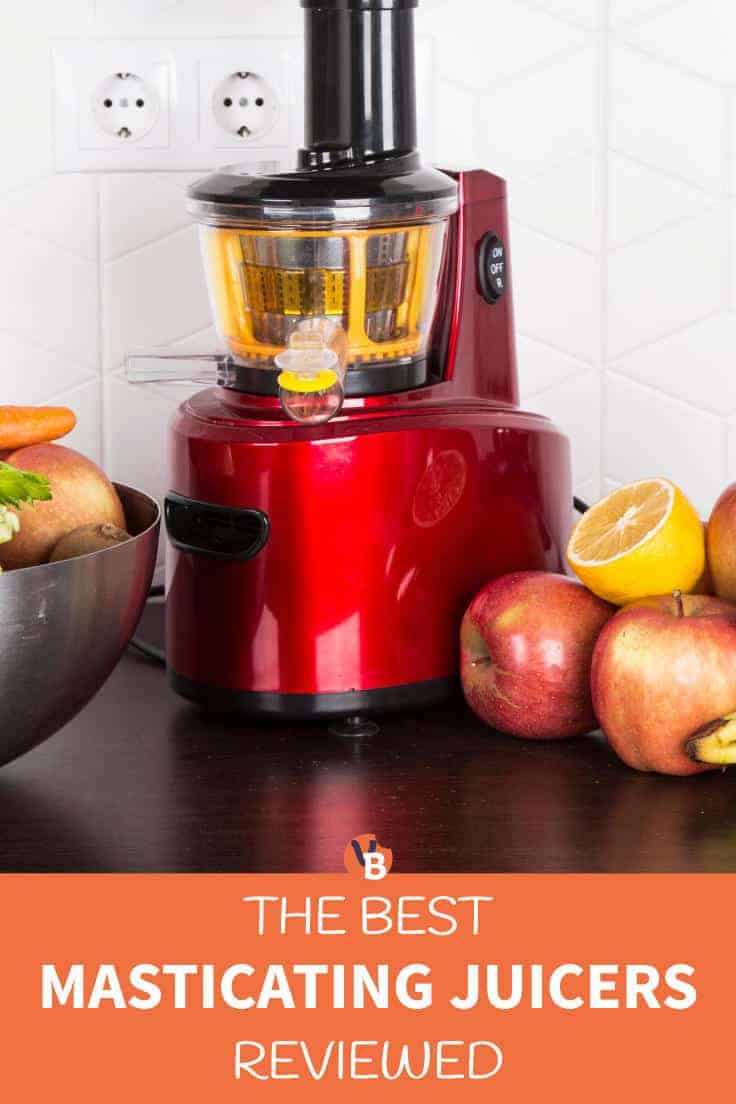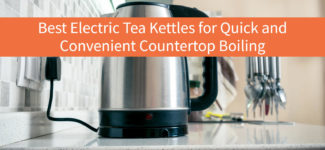I’ve had a chance to take an in-depth look at nearly 2 dozen models from different companies. For this guide, however, let’s narrow it down to what we think are the top 8 masticating juicers of 2020.
Our Top 8 Quick List
Horizontal Masticating Juicers:
- Omega NC900HDC Nutrition System Juicer – Versatile horizontal model with widest feed opening
- Omega J8008C Nutrition System Juicer – Versatile and most budget-friendly horizontal model
Vertical Masticating Juicers:
- Tribest Slowstar Slow Juicer SW – Most budget-friendly vertical model
- Hurom H-AA Alpha Slow Juicer – Most visually appealing vertical model
- Omega VSJ843R Vertical Juicing System – Vertical model with most value for the money
- Hurom HZ Slow Juicer – Most expensive but features premium stainless steel construction
- Omega VRT400 Heavy Duty Dual-Stage Juicer
Wide Chute Vertical Masticating Juicer:
Pros and Cons of Masticating Juicers
Before we get to the recommended juicers, I figured I’d share with you the things you need to know, plus the most common pros and cons of masticating juicers, so you can be sure this is what you’re looking for.
If you’ve ever heard or seen someone say “cold press juicer”, “slow juicer”, or “single gear juicer”, these are simply different terms for masticating juicers.
Masticating juicers come in 2 distinct designs: horizontal and vertical.
A horizontal unit is usually more efficient at juicing leafy greens, grasses, and sprouts, plus it’s multi-functional and can be very versatile.
A vertical unit’s main advantage is being horizontally compact, slightly easier to use and clean, and has a self-feeding operation where you don’t need to (and shouldn’t) use a food pusher most of the time.
While centrifugal juicers work by shredding produce with high-speed spinning blades, masticating juicers do it by crushing, squeezing and pressing your ingredients at a very low speed (generally between 40-80 RPM).
Drawbacks
Let’s start with the drawbacks.
Price
Most people are familiar with centrifugal juicers. These are usually straightforward to use and tend to be very affordable.
Masticating juicers, on the other hand, are generally more expensive, and you’ll often have to spend north of $250-300 for a model that’s at least half-decent and will last.
Learning Curve
Once you’ve got your juicer, you then need to learn how to use it.
Through reviewing a lot of these juicers, I’ve generally found there’s a higher learning curve you need to get through to get the right consistency for your juices and to avoid problems such as jamming or clogging your juicer.
Some produce, like carrots, celery, ginger root, romaine lettuce, wheatgrass and stringy stems, can be more tricky to deal with and they often cause problems if you don’t pre-cut them small enough for your juicer. This applies mostly to vertical models.
Requires Time and Patience
Most masticating juicers have small feed chutes (the opening you’ll drop your produce into).
This means you need to cut your ingredients small enough to fit into the opening.
Lately, though, some companies have been trying to innovate with wide chute models in response to consumer demand.
Either way, expect a typical juicing session to take 15-25 minutes from start to finish.
Can Be Bulky or Tall
Horizontal units are sometimes big and bulky to have sitting on your kitchen countertop.
Vertical units, on the other hand, can be taller than the standard clearance height between the countertop and cabinet in the average kitchen.
This means you might find yourself having to pull out and put away a 20-pound kitchen appliance every time you want to use it.
Mind you, this isn’t necessarily a drawback relative to other types of juicers, as they can be just as bulky or tall.
Not Great for Juicing Only Soft Produce
If you want to juice soft ingredients, especially things like berries and ripe fruit (grapes, mangoes, citruses, papaya, pears, peaches, plums, etc.), you should always combine them with at least one fibrous ingredient.
The pulp from hard produce helps “sweep” out leftover mush from soft ingredients.
Juicing soft stuff on its own can end up clogging your horizontal juicer or giving you a thick purée texture as opposed to a smooth juice.
Benefits and Advantages
Now you know the most critical drawbacks, let’s have a look at the awesome pros.
Efficient Juice Extraction
Boy, I’ve felt the disappointment of juicing whole leaves of kale through a centrifugal juicer only to get a tablespoon worth of juice from it.
This won’t happen with small chute masticating juicers as they are widely known for producing high juice yields.
Compared to centrifugal juicers, you can end up getting roughly 20-30% more juice extracted from bulky produce, and several hundred percent more juice from leafy greens, sprouts, and grasses.
Efficient at Juicing Greens
As mentioned above, if you want to juice greens, sprouts, and grasses, a small chute masticating juicer is the type you’ll want to have.
Otherwise, you’ll see most of your produce simply go to waste.
Low RPM (Revolutions Per Minute) Speeds
Most masticating juicers have a measured RPM between 40-80 while processing ingredients with a slow grind-and-chew effect, which is especially important when juicing wheatgrass and sprouts.
This is super beneficial because it means less air is pulled into your juice, reducing oxidation.
It also means your juice will retain its nutritional value for longer and can in many cases be stored for up to 72 hours.
Easy On Your Ears
A common complaint against high-speed centrifugal juicers is they make it sound like there’s a jet plane taking off in your kitchen.
This can also be slightly harsh on your ears with long-term use.
Masticating juicers, however, generally have very quiet motor operations, which gives you freedom to juice anytime you want without causing disturbance in your household or to your neighbors.
Self-Feeding Design
As I mentioned earlier, vertical masticating juicers come in a design that lets gravity do most of the work when you drop in your produce, so you don’t have to spend time reaching for a food pusher.
How to Choose the Right Masticating Juicer for Your Needs
Build Quality and Design
You want to make sure you’re purchasing a juicer that’ll last.
A couple ways to help determine this is to look at:
- what materials are used in the juicer’s construction (big pluses for Tritan, ABS and GE Ultem plastics, as well as stainless steel)
- reviews from other users and customers concerning the longevity of the juicer and its parts
- length of warranty (short warranties can indicate the company being well aware its product won’t last long)
Also, you’ll need to make sure the juicer’s dimensions don’t make it a bad fit your kitchen (or wherever you intend on using it).
If you think you’ll be traveling with or moving it around often, make sure it’s not too heavy or bulky.
When making lots of juice in a single session, an issue you can run into is having to repeatedly stop to unload the juice and pulp containers because their capacities are too small.
So make sure the juicer comes with big enough containers or that its design allows you to use your own bigger containers.
Is it BPA-Free?
Many people are concerned about bisphenol A (BPA), which is a toxic chemical that’s not only found in common plastics but leaches from them too. BPA is known to cause or play a role in various health issues including fertility problems, impaired brain development, cancers, etc.
While the U.S. Food and Drug Administration states BPA doesn’t present risk to consumer health, there are still valid reasons to be concerned, so it’s recommended to go BPA-free where possible.
I recommend you always make sure every part of the juicer coming in contact with food are BPA-free. This includes the:
- feed chute
- auger screw
- juice bowl
- juice and pulp containers
How Long Is the Warranty?
A solid warranty from a well-established business is always a top-notch bonus.
Sometimes companies will market their juicers as having a 10-year or lifetime warranty.
But what they won’t mention is that it only applies to the motor, which is the part of a juicer that’s less likely to ever break.
In these cases, the detachable parts end up having a shorter warranty like 2 years or less.
For a masticating juicer, try to look for warranties covering the entire machine for at least 5 years.
You’ll find some of the most impressive warranties on the market today from:
- Omega Products
- Kuvings
- Tribest
Juice Quality and Yield
Another thing to consider is the quality and yield you can expect to get from the juicer, which also depends on what you’re thinking of juicing most of the time.
For example, a centrifugal juicer might turn a sizeable bunch of leafy greens into a couple of tablespoons of juice, while a masticating juicer will give you perhaps 1/2 cup yield from the same quantity of produce.
On the other hand, a masticating juicer might turn your soft fruit ingredients into an undesired mush or purée texture, while the centrifugal juicer will give you a smooth glass of juice from the same produce.
Even different types of masticating juicers (horizontal, vertical and wide chute vertical models) have pros and cons.
So you need to find the juicer that’ll work best for your needs.
Performance and Noise
Now, I’m pretty sure most people would choose a quieter juicer if they had the choice.
While centrifugal juicers are among the noisiest kitchen appliances you’ll experience, masticating juicers are generally very quiet in comparison.
But just HOW quiet they are, will differ from model to model. So if you’re living with others in a household, make sure the juicer is quiet enough or that you can use it where it won’t disturb anyone.
For performance, like I covered earlier, remember that masticating juicers are generally very slow to use because they chew and grind ingredients in a way that takes time.
But you’ll also want to make sure the juicer is powerful enough to cope with the ingredients you’ll be juicing most of the time.
Is it Easy to Use?
If the juicer is overly complicated or difficult to use, you’ll probably hide it away and never dare use it again.
So, of course, it’s important you make sure to get a good feel for what it’ll be like to assemble, use, and disassemble the juicer.
For this, you can often find videos of people using various juicers.
Is it Easy to Clean?
Following on from the previous point, if cleaning the juicer is a struggle each and every time, then, well, you’ll likely also quit using it.
One thing that adds convenience for many people, is if the juicer’s detachable parts are dishwasher safe.
But I do have to say, washing, rinsing and drying most masticating juicers by hand really isn’t problematic and takes between 3-8 minutes depending on the model.
Our Top 8 Best Masticating Juicers of 2020
All right, time to dive in so we can help you find the right masticating juicer for your needs.
1. Omega NC900HDC Nutrition System Juicer
No products found.The NC900HDC is Omega’s 6th generation horizontal masticating juicer, featuring a stylish chrome color finish and BPA-free plastic parts.
Compared to the J8008 and earlier generation models, Omega listened to customer requests by equipping this juicer with a slightly larger feed chute so you can spend less time pre-cutting produce. On this top 8 list, it’s the horizontal type juicer with the largest feed chute.
It’s a superb and efficient juicer if you want to get serious about juicing leafy greens, grasses, and sprouts.
Thanks to dual-stage juice extraction technology, it’s efficient and has high extraction yields, leaving behind fairly dry pulp. With the low RPM and gentle processing, your juice is exposed to very minimal air, so it won’t oxidize as fast as when using a centrifugal juicer. You’ll be able to store your juice for up to 3 days.
On top of that, it comes with a food processing cone and interchangeable nozzles for making a variety of food items, which makes this a super versatile kitchen appliance, and is why Omega chose to call it a “Nutrition System”.
So if you’re looking to make purées, sauces, baby food, nut butters, frozen fruit sorbets, pasta, breadsticks and more, you can’t go wrong with this unit.
The juicer is powered by a 150-watt, 2 horsepower motor, which makes it powerful enough to crush fibrous ingredients with relative ease.
While I usually say masticating juicers aren’t the most ideal choice for the total beginner, this one does come with a decent documentation manual with clear instructions on how to assemble the parts.
But still, you’ll need to spend the first few times applying some basic juicing tips to get good results consistently, which helps you enjoy the whole experience.
All the parts can seem overwhelming when you’ve first unboxed them, but after a few tries, it will become second nature.
The Omega NC900HDC is also easy to clean and you can do it by:
- giving the parts a quick rinse and setting them to dry
- soaking the parts in a liquid solution for 30 minutes, then rinsing them off
- placing the parts in the dishwasher on the top rack
While it’s somewhat heavy at 20 pounds, it features a nice carrying handle you can use to move it around safely.
As with all Omega’s juicers, you’ll get an awesome 15-year warranty on the entire unit, which is one of the most impressive deals on the market.
Who’s This Juicer For?
I would recommend the Omega NC900HDC for someone who’s interested in a modern-looking horizontal juicer sporting some of Omega’s latest design features.
But you also need to justify the price difference between the NC900HDC and the 5th generation NC800HD.
Why? Because they’re identical except for being available in different color finishes, yet the NC900HDC is considerably more expensive.
Back to the Omega NC900HDC, if you want to go for juicing mainly leafy greens or you’re thinking about starting a juice cleanse, this is definitely a great choice!
Pros
- Really good for juicing leafy greens and hard produce
- Efficient juice extraction, leaving dry pulp
- User-friendly setup for beginners
- Impressive 15-year warranty
Cons
- Some plastic parts seem fragile when juicing tough produce
- Bulky and takes up a bit of space
- Requires slight learning curve to avoid difficulties and pulpy juice
- Prone to terrible performance with soft fruits
2. Omega J8008C Nutrition System Juicer
No products found.Let’s say you still wanted a juicer with a visually appealing chrome finish but at a price comparable to the NC800HD. That’s where the 5th generation Omega J8008C horizontal masticating juicer comes in.
Would there be a compromise if you got this one instead, you ask?
Yup, the smaller, round-shaped feed chute measures 1.5 inches in diameter, which means you would need to spend a bit more time cutting your ingredients small enough to fit.
The J8008C (and twin model J8007) is an upgrade to the widely embraced J8006 Nutrition Center juicer and features some key upgrades, such as:
- a purpose-built grip lip handle so you can move it around easier
- a bigger, detachable produce tray
- the juice screen filters are constructed of stainless steel
With pretty similar parts and a 150-watt, 2 horsepower motor, it’s equally as versatile and powerful as the NC900HDC, letting you prepare baby food, sorbets, minced herbs, garlic, nut and soy milk, nut butters, pasta and breadsticks and so forth.
It’s also dishwasher safe and the plastic parts coming in contact with food are BPA-free.
You get the same impressive 15-year warranty on the entire machine so you’ll have nothing to worry about on that front.
Who’s This Juicer For?
Like the NC900HDC, this is an excellent juicer and will definitely get the job done if you want to mainly juice leafy greens, grasses and sprouts.
This one is indeed cheaper, so I suggest getting the J8008C if your budget is slightly restricted and you want to save some money. Just remember you’ll be spending a bit more time preparing produce with this model.
Pros
- Dual Stage juice extraction gets more juice from your produce
- Very efficient with leafy greens, hard produce and wheatgrass
- Quiet in operation so you can juice on mornings and late evenings
- User-friendly and easy-to-clean
- Long 15-year warranty
Cons
- Struggles with certain produce, especially citruses, berries, and pineapple
- Horizontal design makes it slightly bulky
3. Tribest Slowstar Slow Juicer SW
No products found.The Tribest Slowstar is a vertical masticating juicer from Tribest and comes in two slick color variations (red/black and silver/black). Its design makes it compact and easy to fit in most kitchens even if space is scarce.
One feature that makes this juicer stand out from similar models, is its 200-watt motor with 3-stage speed reduction gears, which gives it greater crushing power than most other small chute vertical models.
Because of this, the Tribest Slowstar doesn’t struggle the same way with hard produce like beetroot, carrots, and parsnip, which frequently cause other juicers to jam if you don’t cut them small enough.
So this juicer won’t give you as much trouble with fibrous and tough produce.
For the GE Ultem auger screw, Tribest developed their patented Duoblade Double-Edge design, which processes ingredients faster (but at the expense of reducing the juicer’s ability to self-feed, so you might need to use the food pusher sometimes).
With this juicer, you’ll get efficient juice extraction from produce and thanks to a slow 47 RPM, a long-lasting juice with minimal oxidation.
And who said vertical slow juicers can’t be versatile? Well, this one certainly is with the accompanying Mincing Attachment, which lets you make:
- frozen fruit sorbets
- minced herbs
- ground coffee beans
- nut butters
So if you feel like getting a bit more creative in the kitchen, the Tribest Slowstar will help you do just that.
There’s a convenient carrying handle too so you can move the juicer around.
All parts coming in contact with food are BPA-free.
As for cleaning, you won’t be able to use your dishwasher as the parts, unfortunately, aren’t dishwasher safe. But a manual cleaning by hand shouldn’t take you longer than 5 minutes.
Like most vertical juicers, it features the auto-cleaning system powered by the auger and wiping blades, which:
- helps keep the juice bowl clean and moves pulp through during juicing
- lets you quickly rinse out internal parts by pouring water through the juicer
The fact you can pour water through to rinse the parts is especially great when you want to make multiple recipes in succession. This way, you won’t need to disassemble the parts to clean them between each recipe.
This juicer comes with a terrific 10-year warranty on the entire machine.
Who’s This Juicer For?
There’sn’t much to not like about the Tribest Slowstar.
So here are my thoughts: The main advantage it has over other vertical juicers is the motor and 3-stage speed reduction gear performance.
It helps make this one of the most trouble-free small chute vertical masticating juicers when juicing hard produce.
A slight concern I have, however, is despite a price tag north of $300, there’s been several users questioning why seemingly fragile plastic parts were used in the juicer’s construction. It can feel like some of the parts might break when juicing tough ingredients consistently.
But the long warranty definitely helps offset that concern.
I would mostly recommend this as a great choice for people who are already experienced with masticating juicers because it comes with a bit of a learning curve to get the best out of it.
Pros
- Powerful motor and gear mechanism lets this juicer easily handle tough produce
- Horizontally compact vertical design makes it an easy fit in most kitchens
- Efficient juice extraction gives you decent bang for your buck
- Mincing attachment adds plenty of possibilities for what you can make
- Low noise level lets you juice whenever you want
Cons
- Requires a learning curve to get consistently good results
- Built with potentially fragile and cheap plastic parts
- Steep price-point, especially for beginners
4. Hurom H-AA Alpha Slow Juicer
No products found.Hurom’s H-AA Alpha juicer is easily one of the most beautiful vertical masticating juicers I’ve seen so far. It features Hurom’s latest Alpha design technology, which, compared to earlier models, makes the juicer:
- more optimized for juicing
- easier to clean
- able to make ice cream
For color options, you can choose between a matte black and rose gold.
The juicer’s parts are built out of ABS, Tritan and extra durable GE Ultem plastics, which increases its longevity. All parts coming in contact with food are BPA-free.
If you want a versatile juicer, you’re covered. The Hurom H-AA Alpha comes with two different strainers (fine and coarse) which not only helps control the pulp content of your juice, but also lets you achieve different textures.
So this juicer will let you make:
- juicers
- sauces
- milkshakes
- smoothies
- nut and soy milk
- tofu
- ice cream and frozen fruit sorbets
With so many possibilities, you’ll never run out of ideas on what to make.
Some people like pulp in their juice, others prefer it to be as smooth as possible.
As well as two strainers, this juicer also features a Pulp Control Lever. This lever, together with the strainers, gives you maximum control over pulp content.
Like all of Hurom’s juicers, the auger rotation speed is rated at 43 RPM, so you’ll get a low-oxidized juice with decent nutrient retention; a juice you can store for up to 72 hours.
If you’re a total beginner to juicing, you’ll need to be ready to commit to a small but worthwhile learning curve to:
- avoid jamming the juicer
- get your desired texture and consistency
- get consistently high yields from your produce
Assembling and taking apart the juicer is something you’ll pick up quickly.
The Hurom H-AA Alpha is very efficient at extracting juice from your ingredients, so you’ll get a lot of bang for your buck.
It works best for juicing hard and bulky produce, leafy greens, citruses and wheatgrass.
The juice bowl’s spout has a neat open/close cap.
You can use the cap to thoroughly mix ingredients within the juice bowl before releasing the contents or as part of quick-rinsing the juice bowl, juicing screen and auger, between recipes or just before you disassemble the parts.
Another great use for the cap is to prevent dripping when removing the juice container.
Like the Tribest Slowstar, it also features the auto-cleaning system, which is driven by the rotation of the auger screw, which then rotates the wiping blades and keeps the juice bowl clean.
If you like juicing on mornings or in the evening, you’ll be thrilled with how quiet the motor is.
The warranty covers the motor for a good 10 years, but the much shorter 2 years on parts does leave something to be desired.
Who’s This Juicer For?
The Hurom H-AA Alpha is mainly for those who want a sleek and premium-looking piece of engineering sitting on their countertop. You’ll not only love how this thing looks but you will also get an efficient and quiet juice extractor.
Pros
- Eye-catching and compact vertical design taking up minimal space
- Performs efficient juice extraction, giving you more bang for your buck
- Versatile juicer for making juice, smoothies, baby food, purées, nut and soy milk, etc.
- Very quiet and can be readily used on mornings or late evenings
- Convenient self-cleaning feature
Cons
- Is prone to jamming often if produce isn’t cut small enough
- Not powerful enough to crush hard produce like carrots consistently without jamming
- Requires a bit of patience and preparation time
- Steep price point for people new to juicing
5. Omega VSJ843R Vertical Juicing System
No products found.The Omega VSJ843R vertical masticating juicer is compact and one of the best masticating juicers for the money.
It’s part of Omega’s VSJ843 series, which comes in a round (VSJ843R) and square (VSJ843Q) model. The square model is slightly bulkier, but its on/off/reverse switch is located on the front of the machine, whereas the rounded version has its switch located on the back.
You have two color choices to pick between, red (VSJ843RR) and silver (VSJ843RS), with silver being the most popular option.
Its parts are built of good materials such as stainless steel (juicing screen), GE Ultem plastic (auger screw) and BPA-free plastics for all parts coming in contact with food.
While not as versatile as some of the other options on our top 8 list, you’ll still be able to make:
- juicers
- frozen fruit sorbets
- smoothies
- nut milk
This is another excellent juicer for leafy greens, grasses, and sprouts.
While it’s also great for hard produce like carrots and parsnip, make sure to cut these ingredients small enough and feed them slowly into the chute opening to minimize jams and blockages.
The 150-watt motor rotates the auger screw at a slow speed of 43 RPM, so again, you’ll be able to make great tasting juice with minimal oxidation which you can refrigerate up to 3 days.
Compared to the Hurom H-AA Alpha, you get the same level of efficiency, quiet motor operation, and compact design along with a much better 15-year complete warranty and dishwasher safe parts.
However, the Omega VSJ843 isn’t as “slick-looking” or versatile. It’s also twice as heavy (22 pounds versus the H-AA Alpha’s 10.6 pounds).
Who’s This Juicer For?
If you’ve looked at the Hurom H-AA Alpha and don’t think you have a need for making tofu or soy milk and the looks of the machine doesn’t matter to you, then, by all means, grab yourself an Omega VSJ843 juicer.
While this juicer from Omega does have some weaknesses with hard produce and stringy ingredients like celery, chard stems and wheatgrass, it’s still a decent all-rounder and performs really well.
And hey… It doesn’t get much better than a 15-year warranty anywhere on the market.
Pros
- Quiet motor ensures you can juice anytime without disturbing anyone
- Auto-Cleaning System reduces clean-up time
- Juice flap stops juice from dripping and lets you quickly rinse juice bowl between recipes
- Appealing 15-year warranty on motor and all parts
Cons
- Hollow auger screw design leads to pulp buildup, increasing cleaning time
- Doesn’t perform well with soft fruits and certain hard produce like carrots and celery
- Lack of motor power can sometimes cause juicer to stop when processing hard produce
- It’s heavy and features no carrying handles for convenience
6. Hurom HZ Slow Juicer
No products found.The Hurom HZ slow juicer is another awesome juicer from Hurom, sporting a very modern and durable stainless steel construction along with LED status indicators. It gives off a “juicer from the future” type of feel.
The stainless steel build makes this seem like a kitchen appliance that’ll last a long time, especially if used with care.
Other important parts are built using ABS, tritan and GE Ultem plastics, all of which are sturdy materials.
Any plastic component coming in contact with food is BPA-free.
Just like the Hurom H-AA Alpha, you’re getting a super versatile juicer you can use to make:
- juicers
- smoothies and purées
- nut and soy milk
- ice cream and sorbets
- baby food
- homemade sauces
- tofu
It also features the same Pulp Control Lever and fine and coarse strainers, which lets you control the amount of pulp you’d like in your juice.
You also get a third “ice cream” strainer built from BISEN plastic. As the name implies, you’ll be using this strainer for making ice cream.
The juice bowl has a convenient cap attachment you can use to stop contents from flowing out of the juice spout.
As already mentioned, this lets you mix ingredients more thoroughly inside the juice bowl, as well as letting you fill the juice bowl with water to give internal parts a quick rinse.
Once you’ve spent some time going through the initial learning curve for the ins-and-outs of juicing with a vertical masticating juicer, the Hurom HZ will be pretty straightforward for you to use.
The challenge most people will run into is when they cause the juicer to jam because the ingredients weren’t pre-cut small enough.
The Hurom HZ is easy to assemble and take apart after you’ve tried it a couple of times.
When it comes to cleaning, the unfortunate drawback for all Hurom’s juicers is that the auger screw is the only dishwasher safe part.
But the juicer’s auto-cleaning system and juice spout cap attachment help make up for it by reducing cleaning time.
This juicer is also covered by a 10-year warranty for the motor and 2 years on parts.
Who’s This Juicer For?
There’s no doubt this is a premium kitchen appliance at a premium price. In fact, it’s one of the most expensive juicers we’ve reviewed, hovering around $600.
So I’ll mostly recommend this one for people who’re all about the luxurious experience while at the same time getting an efficient and versatile juicer.
Pros
- Very appealing stainless steel body construction with LED light indicators
- Very versatile appliance for making juices, smoothies, sauces, nut milk and more
- Compact vertical design makes it easy to fit in most kitchens
- Self-cleaning system helps make up for non-dishwasher-safe parts
Cons
- Is prone to jamming often if produce isn’t cut small enough
- Not powerful enough to crush hard produce like carrots consistently, without jamming
- Very steep price point for people new to juicing
7. Omega VRT400 Heavy Duty Dual-Stage Juicer
No products found.The VRT400 Heavy Duty Dual-Stage Juicer is another great vertical masticating juicer, which comes with improvements from Omega’s previous VRT350 and VRT380 models.
You get the same self-feeding vertical design, which means you can juice more without needing to use a food pusher as long as you cut ingredients small enough and don’t overload the juicer.
If a jam or blockage does happen, there’s a reverse function you can use to help loosen and move things along.
The two most important upgrades are:
- The juicing filter is now heavy duty and can resist strenuous usage as it’s been built from ultra strong GE Ultem plastic
- The juice bowl’s spout now has a patented juicer tap attachment
The tap allows you to mix ingredients inside the juice bowl for a more flavorful juice. It also:
- lets you fill the juice bowl with water to rinse internal parts
- prevents juice from dripping when you remove the juice container
Compared with other masticating juicers on this list, it has a slightly higher RPM at 80 but you’ll still be able to make healthy juice that you can store and refrigerate for up to 72 hours.
The higher RPM does, however, mean you won’t be able to get as much extraction from baby greens, grasses, and sprouts, as you would with a lower RPM juicer.
But maybe nut and soy milk, as well as purées are more your thing, in which case this juicer will be superb for your needs.
Of course, it also performs decently with a variety of hard and soft produce.
As for warranty, you get 15 years on the whole machine, which of course is a great deal.
Who’s This Juicer For?
I recommend this juicer specifically for people who are already users and fans of the previous VRT350 and VRT380 models.
If you’ve been happy with either of those, you’ll absolutely love this upgraded model.
Otherwise, the VRT400, which used to be Omega’s flagship vertical masticating juicer until the VSJ843 series came out, with slightly better performance and a slower 43 RPM, making them better for juicing leafy greens, grasses, and sprouts.
Pros
- Significant upgrade features from previous models
- Heavy Duty filter screen
- Make nut milks and baby food as well as juices
- Small footprint requiring little space on your counter
- Self-cleaning system that really works
- 15-year warranty
Cons
- Small, but necessary, learning curve to get the best from it
- Slow compared to centrifugal juicers
- Soft fruits and vegetables produce a purée
8. Kuvings C7000 Whole Slow Juicer Elite
No products found.Okay, now we’ll be switching things up a bit.
Through the years, people have been asking for a solution that would bridge the faster-juicing experience of centrifugal juicers with the key advantages of masticating models.
This way, you could get high yields and long-lasting, low-oxidized juices from a quiet machine, and yet not have to spend as much time as it usually takes with a masticating juicer.
The result? Masticating juicers with much wider feed chutes.
The Kuvings C7000 Whole Slow Juicer Elite from Kuvings is an excellent choice for a wide chute masticating juicer.
Kuvings were actually the first company to develop and launch this patented design, starting with the C7000’s predecessor, the Whole Slow Juicer B6000.
Based on customer feedback, the C7000 has entered the market with improvements made to various parts, including the:
- motor base
- juice drum
- juice screen
- blank strainer
- auger
This juicer features a 17.5-inch vertical, self-feeding design, with a 3-inch wide chute opening.
Now, while they might say you can stuff everything into the chute without ANY pre-cutting, it’s not really best practice, plus a lot of bulky produce will still be too big to fit.
So you should still expect to spend some time—although not as much as with small chute juicers—preparing your fruits and vegetables.
The auger screw and juicing screen are built from GE Ultem plastic material and all parts coming in contact with food are BPA-free.
Kuvings calls this a “3-in-1 juicer” because you can use it to make:
- juices (using juicing screen)
- smoothies (using smoothie strainer, purchased separately)
- frozen fruit sorbet and ice cream (using blank strainer)
For your juices, you get a custom-designed sieve strainer, which fits perfectly on the supplied juice container and will help remove pulp from your juices.
The juice bowl’s spout has a non-drip “Smart Cap” with a metallic finish, which prevents dripping as you remove the juice container from the juice spout.
One thing I really enjoy about these juicers is you’ll have much less trouble with jams from juicing common ingredients like carrots, beetroot, and parsnip. The 240-watt and 3-horsepower motor give it a more crushing power which makes a big difference.
However, IF you want to juice a lot of carrot and celery specifically, the Kuvings C7000 might not be the best fit.
With some basic juicing tips and a few attempts using this juicer, you’ll find it very easy to use while probably have fun too!
Despite packing as much power as it does, it’s quiet, so you can switch it on and juice pretty much whenever you feel like.
The parts must be cleaned by hand as they aren’t dishwasher safe. Cleaning should take you no longer than 5 minutes and you get some useful cleaning brushes.
The Kuvings C7000 comes with an impressive 10-year warranty on the entire machine, so you’ll have little to worry about there.
Who’s This Juicer For?
A wide chute masticating juicer is a great compromise between a small chute masticating and regular centrifugal juicer, especially if you want a bit more convenience and to save time.
You’ll get good quality juice and decent yields, and not have to deal with the loud motor performance from high-speed centrifugal machines.
If you’re a total beginner to juicing, I would recommend getting a wide chute juicer to start with, and the Kuvings C7000 is a superb choice for this.
Once you’re ready to get serious about juicing leafy greens, wheatgrass, and sprouts, that’s when you can think to go for the small chute vertical or horizontal juicers.
Pros
- 3-inch wide feed chute reduces time spent pre-cutting produce
- Low noise level lets you juice whenever you feel like it
- Versatile 3-in-1 juicer, letting you make juices, smoothies and frozen fruit sorbets
- BPA-free plastic components
Cons
- Despite wide feed chute, you do still need to cut produce for best performance
- Parts are not dishwasher safe
- Steep price, especially for beginners
Masticating Juicer Buying Guide Conclusion
As you can see, finding the right masticating juicer can be a bit of a jungle to navigate because there are actually many good options to choose from at varying price points.
A few rules of thumb:
If you’re looking for a juicer that’s really excellent for juicing leafy greens, wheatgrass, and sprouts, definitely go for a HORIZONTAL masticating juicer.
These can be time-consuming to use but they’ll give you the most value for your money when juicing those kinds of produce.
If you want a juicer with a compact design, versatility, and well-rounded performance with most types of produce, go for a SMALL CHUTE vertical masticating juicer.
They aren’t as efficient juicing grasses and sprouts (and often end up jamming or clogging from these ingredients if you don’t pre-cut small enough), but they require less effort, take up less space, and are generally easier to use and clean.
If you don’t fancy spending as much time cutting produce to fit small feed chutes, and you don’t think you’ll be juicing a lot of baby greens, grasses or sprouts, then go for a WIDE CHUTE vertical masticating juicer.
These models also aren’t great for juicing greens, and the juice they produce can be fairly pulpy, but they’re very beginner-friendly, they’re much harder to jam, and will make juicing faster.
Hope this guide helps you find a juicer that’ll meet your needs!








